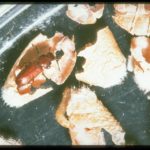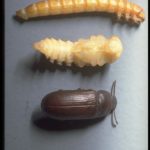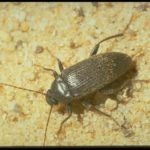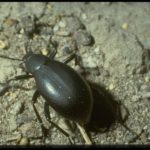Common Name: Various
Scientific Name: Varies
Order: Coleoptera
Description: This 1/8 inch long, flattened, reddish brown beetle may appear somewhat shiny. The shield behind the head (pronotum) has minute punctures and the wing covers (elytra) are grooved (striate) with sparse punctures.
The most common relative to the confused flour beetle is the red flour beetle, Tribolium castaneum (Herbst), which can be even more abundant in the south. The biology and appearance is similar and the two species may occur together in stored food. The red flour beetle has the last three antennal segments enlarged abruptly and of equal size, but it lacks the notched expansion of the head behind the eyes and has the eyes farther apart than in the confused flour beetle. A number of other beetles and caterpillars also may infest stored products. Larger species (adults are almost ½ inch) of tenebrionid beetles, the yellow mealworm, Tenebrio molitor Linnaeus, and dark mealworm, T. obscurus Fabricius, are also occasional stored product pests, but they are probable better known because they are cultured and sold commercially as fish bait and pet food for reptiles, amphibians, and other insect feeders. Cylindrical, hardened, shiny, yellow or brown colored larvae (color is characteristic for the species), develop through 14 or 15 stages (instars) before pupating, producing one generation per year.
Life Cycle: Adult beetles are active and move about irregularly, hence the name. They can live for over a year. Eggs laid by females hatch in 5 to 12 days. Larvae are white, tinged with yellow, slender and cylindrical. They develop through 5 to 12 stages (instars) and grow to about 3/16 inch long over as few as 30 days. They have two short appendages on the end of the last abdominal segment. There may be 5 generations per year.
Habitat and Food Source(s): Mouthparts are for chewing. Found in stored food products like flour, cereals and other products (e.g., dried beans, peas, peppers and fruits, shelled nuts, spices chocolate, snuff, museum specimens and some drugs). Adults and larvae feed throughout stored food primarily in milled or prepared products. They are perhaps the most common pest of processed flour. This species is often used as a test animal in laboratory experiments because it is easy to keep in culture.
Pest Status: Found world-wide infesting stored food; infestation may affect flavor of product; medically harmless, even if ingested.
For additional information, contact your local Texas A&M AgriLife Extension Service agent or search for other state Extension offices.
- Confused flour beetle, Tribolium confusum Jacquelin du Val (Coleoptera: Tenebrionidae). Photo by H. A. Turney.
- Yellow mealworm, Tenebrio molitor Linnaeus, (Coleoptera: Tenebrionidae), larva, pupa and adult. Photo by Drees.
- A tenebrionid, Lobopoda sp. (Coleoptera: Tenebrionidae). Photo by Jackman.
- A tenebrionid, Eleodes sp. (Coleoptera: Tenebrionidae). Photo by Jackman.
Literature: Ebeling 1978; Metcalf et al. 1962; Swan & Papp 1972.



